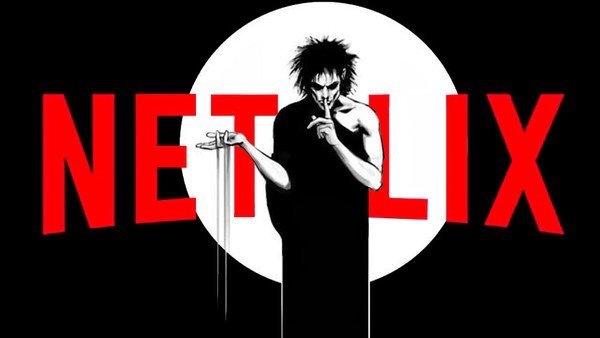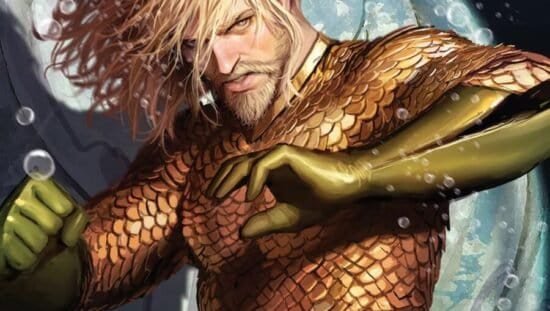If you have been reading articles from this site, it’s no secret that The Sandman is one of my all time favorite comics. The Sandman created a universe of its own, with many titles and spin-offs that are worth reading to expand the experience of reading the main book. In this article, we’ll explore which are the best Sandman universe related comics that you MUST read to fully enjoy and understand the characters.
Along the series, Neil Gaiman brings elements from almost every literary source you can dream about (pun intended), and creates a beautifully crafted story that sometimes is easier to enjoy than to understand. This comic is so great to read that it easily fits in the ranks of the best comic books ever published.
Netflix purchased the rights to produce the Sandman TV series version, and started shooting in October, 2020. Up to the date of writing these lines (January 2021) the full cast of the series hasn’t been disclosed, but this quickly became one of the most expected series of 2021. It’s has been said that The Sandman series was an “impossible to make” one. In this case, Neil Gaiman (@neilhimself) has been consulting and adapting the story himself, so let’s hope for the best.
In the meantime, there are many excellent comics from The Sandman universe that you can read. I decided to go one step further from the main Sandman story, which you might have probably read, and recommend you the best Sandman related series. Some of them are focused on Morpheus, the main character from the main series, and some of them are centered on some of the rich supporting cast that includes interesting characters such as Death, Lucifer, Cain and Abel, The Corinthian, and many, many others.
Are you ready to explore the best Sandman universe related comics? Let’s do it.
Best Sandman Universe related comics
The Sandman (main series)
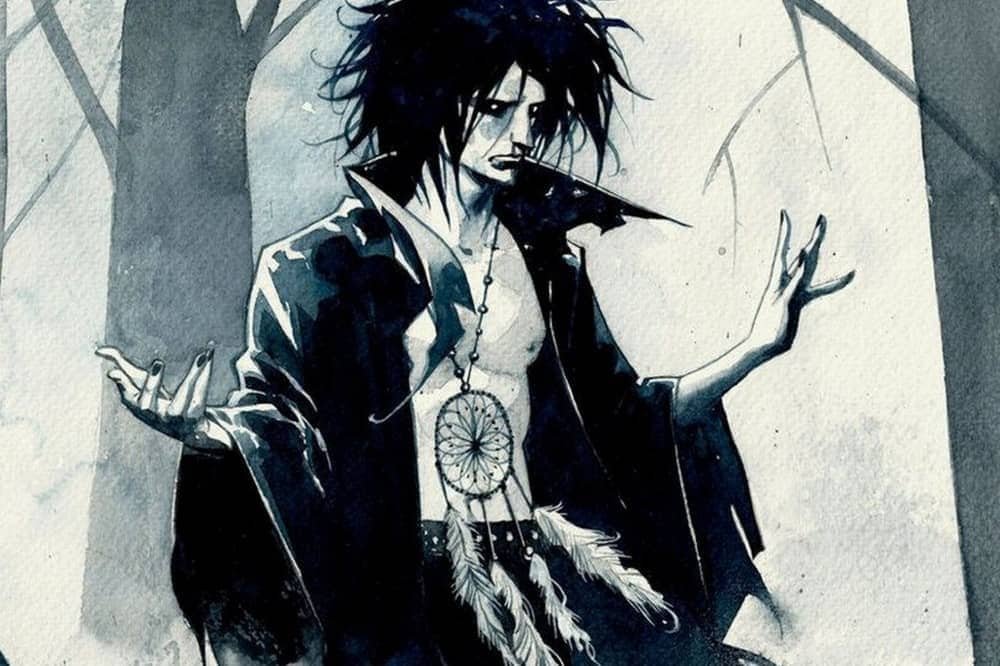
Ok, this is the basic one, but if you haven’t read it, do it. And if you have read it, do it again. The Sandman is so rich in details that you’ll probably find things you didn’t catch the first time you did it.
What’s The Sandman about? The Sandman tells the story of Morpheus, the Lord of Dreams, which we find at the beginning of the story, in 1916, captured and imprisoned by a group pf occultists. When Morpheus finally manages to escape, in 1988, he fights to regain control of the Dreaming, his realm, and his powers.
This is just the beginning of the story: through the 75 issues of the main comic series, published by DC Comics’ Vertigo imprint, The Sandman makes us travel in time and space to unexplored territories, as Morpheus fulfills his role of inspiring the dreams of every person in the world.
As I mentioned earlier, Gaiman mixes elements and characters of history, many religions and mythology along the book, with stories closer to classic horror, retellings of classic stories (such as the beautiful “The Song of Orpheus”), and some touches of classic comic books characters along the way.
In the main series we get also to know Morpheus’ brothers and sisters: Destiny, Death, Despair, Destruction, Desire and Delirium. Together with Dream (Morpheus), they’re called the Endless, and they are the inspiring forces behind all things that happen in our world.
The story reads as a whole, due to the fact that Gaiman includes elements and characters that appear to be minor in some issues, but they happen to reappear in later issues with unforeseen consequences.
As a matter of fact, one of the great hits of the book is it’s cast of characters: from the Endless family to Lucifer and Loki and Egyptian gods. From obscure characters that appeared as introductory characters from horror books in the 70’s such as Destiny, Cain and Abel and Lucien, to Matthew Cable (who appears as Matthew The Raven) from the pages of The Swamp Thing and William Shakespeare. The cast is incredibly heterogeneous and rich.
By now, you may read the book collected in 10 trades, buy the boxed set, go for the Omnibus versions, or a new print in Deluxe format. In this case, due to the quality of the material, I recommend you to get the best editions available, because you might want to read them and re-read them again many times…
Any format you choose, please check the contents of each book if you mix editions. There might be things that are included on one edition and not included in the other. When you mix, you might risk losing some material.
The Sandman Audible Book
This is a completely new experience that gets to your mind and your senses in a totally different way. A great choice to access the Sandman Universe best comics in a totally different way.
Neil Gaiman is co-executive producer of this adaptation, which is adapted and directed by multi-award-winner (and frequent Gaiman collaborator) Dirk Maggs.
A cast full of stars plays the roles of The Sandman characters. James McAvoy plays Morpheus, while Kat Dennings stars as Death, Taron Egerton as John Constantine, Michael Sheen as Lucifer, Andy Serkis as Matthew The Raven, and many more stars. And none other than Neil Gaiman himself narrates the story… I can’t wait to hear this version!
You may try Amazon Audible FOR FREE for a month and hear this audiobook FOR FREE by clicking the button below.
The Sandman: Endless Nights

This is truly a masterpiece. The book includes seven short stories (not so short, since they’re about the length of a single comics each) about each of the Endless family characters. Each story is portrayed by a different artist. Just to give you some samples, Milo Manara (who else?) makes a hot story about Desire, Bill Sienkiewicz is the artist for the Dellirium story, and Frank Quitely paints the Destiny segment. Other artists on the book include P. Craig Russell, Miguelanxo Prado, Barron Storney and Glenn Fabry. If you like comics, you must love this team!
This is really great material, because we Sandman readers always love more material about the Endless family, because the stories are great, and because the art is really, really good. This last aspect is maybe one of the lowest ones of the original series, which had many artists changes, and not all of them were as good as the series deserved.
This book is really a must have for any Sandman lover. However, I don’t recommend you to buy this book if you haven’t read the original Sandman series. So start there, please, and then come here happily.
If you are lucky enough to get your hands on a hardcover version with a reasonable price, be my guest. This is really one of the most exquisite books you can add to your collection
The Sandman: The Dream Hunters

This is a curious book. This was the first Sandman book published after the end of the original series, but was published in the form of novelized prose, illustrated by Yoshitaka Amano. The book tells the story about the love affair between a buddhist monk and a fox spirit, and it’s based on an old Japanese folk tale.
The story can be read on its own, but of course, you enjoy it more if you previously know who the lord of Dreams is. It was awarded the Bram Stoker Award for Best Illustrated Narrative.
What’s the curious thing about this book? That almost 10 years later, for the 20th anniversary of The Sandman, DC Comics launched a comic adaptation to this story, fully illustrated by P. Craig Russell. It was originally launched as a 4-issue miniseries, with covers by Yuko Shimizu, Mike Mignola, Paul Pope and Joe Kubert.
So you can get the original novelized and illustrated story, or the full comic version one. Or you can get both to compare how well the original story adapts to comics. Any one you choose, you´ll be reading a beautiful, great Sandman story.
The Sandman: Overture
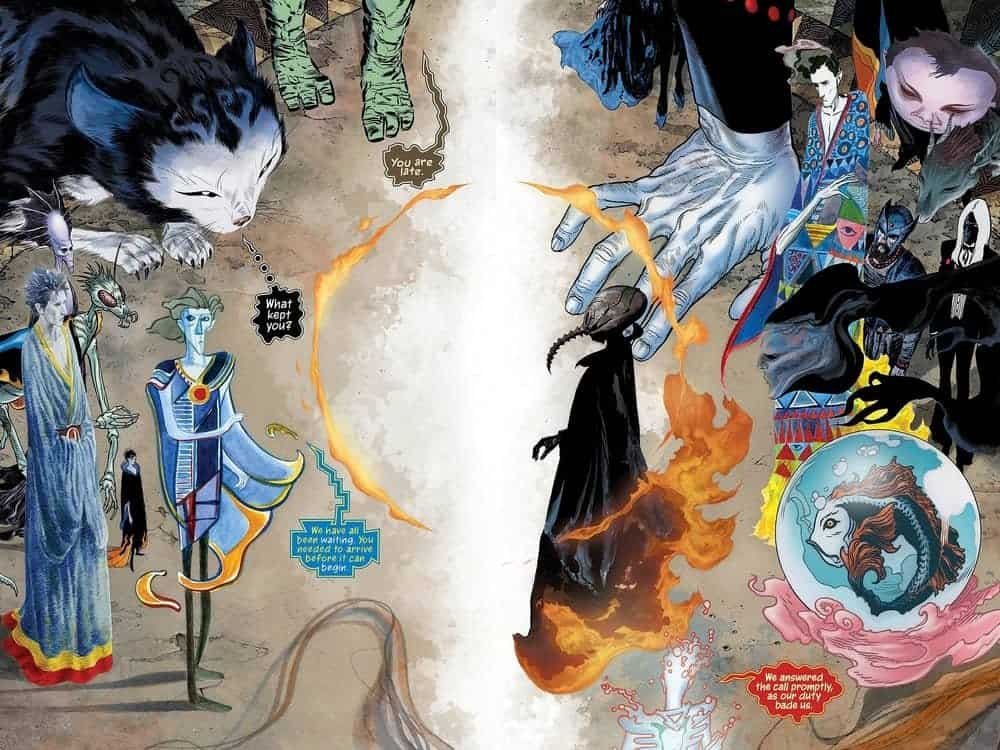
Published 25 years after the launch of the Sandman series, this incredible story is really a prequel of the original one. The story goes literally from the beginning of times to the moment where Morpheus is captured at the beginning of the original series.
There’s a question that pops up then from that knowledge. Should I read The Sandman Overture before reading the Sandman series? No! Gaiman fills the story with many characters we came to know in the original series. Even when the events happen before the original run, you enjoy much more this miniseries by understanding who the characters are, knowing more about their motivations and backgrounds, etc.
The art on this book deserves a highlight, with JH Williams III at his best. His pages give the epic feeling the story deserves.
The book was awarded the Hugo Award for Best Graphic Story in 2016, so again, you have a warranty of a good book here.
Death: The High Cost of Living & Death: The Time of Your Life
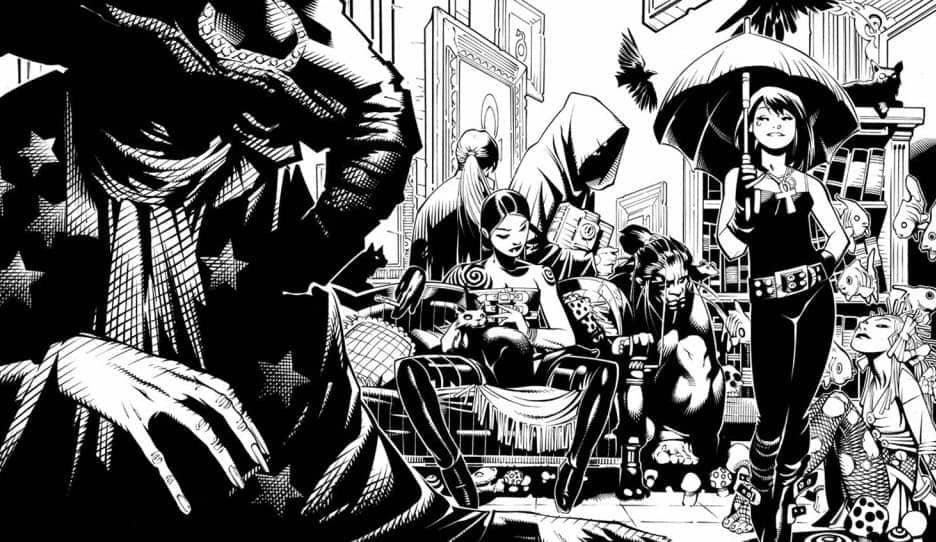
Since her introduction as a happy go-round gothic young woman in issue 8 of the original series (in the wonderful “The Sound of Her Wings” story) Death became an instant fan favorite character. That´s why in 1993 and 1996 the Vertigo imprint launched these two 3 issues miniseries.
The first one, The High Cost Of Living, is written by Neil Gaiman and has art by Chris Bachalo and Mark Buckingham. In this book, Death takes human flesh one day every century. The idea would be to get in touch with the beings she will take to her realm in the future, and “taste the bitter tang of mortality”.
This time, she takes the form of Didi, a teenage goth girl who finds a cast of excentric characters along her journey. Gaiman received an Eisner award as best writer for this title, as well as Karen Berger for best editor. So you know you might expect a great book here.
The second series, The Time of Your Life, is from 1996, and has the same Gaiman / Bachalo / Buckingham creative team from the first miniseries. tHis time, the story centers on on Foxglove, a successful singer, and her lesbian partner Hazel.
When Hazel’s son Alvie dies, Death comes to take him. But Hazel makes her a desperate proposal: if she allows Alvie to live longer, either Hazel or Foxglove would take his place when Death returns. It’s an emotional story about love, living public and private lives, and duty.
Also awarded the GLAAD Media Award for Outstanding Comic Book in 1997, this is another book you’ll really enjoy to read.
You may buy the two separate trades, but it would be a really good buy to get the compiled Death paperback, that includes both stories. These are really good stories worthy to be considered some of the best Sandman universe comics!
Lucifer
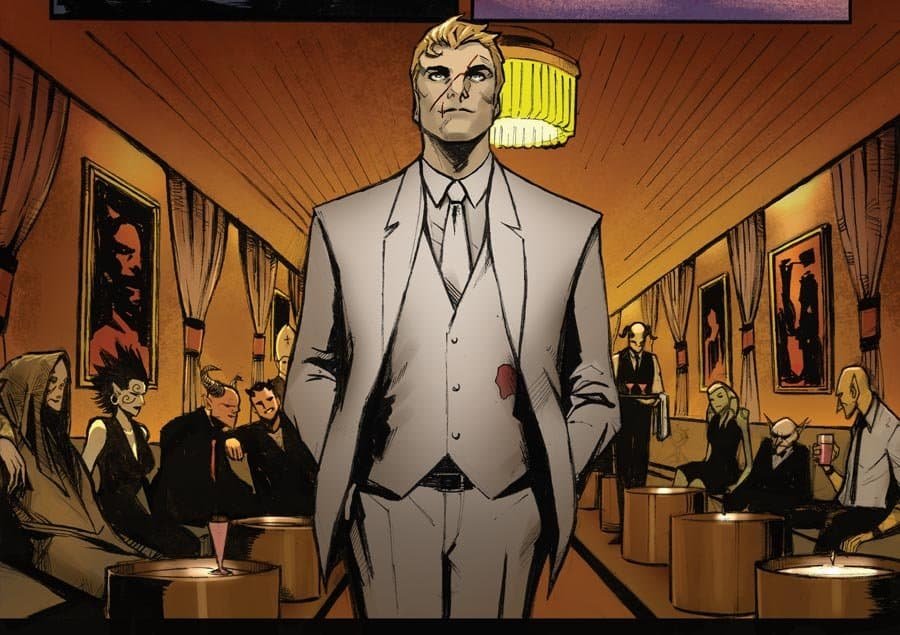
We start here with the spin-offs here, and we start with which is probably the best one. Written by Mike Carey, Lucifer started its own miniseries in 1999, and later on the regular series lasted for 75 issues from June 2000 to August 2006.
The David Bowie look alike character appeared for the first time in the Sandman universe in the regular series, in issue 4. But gains the real spotlight during the “Season of Mists” storyline, where bored of ruling hell he decides to retire and hand the keys of hell to Morpheus.
Lucifer will then set up first in Perth, Australia, an later on in Los Angeles, California, where he owns a piano bar called Lux. There are some common elements with the TV series that you might have seen in Netflix, such as his portrayal as a charming and sophisticated man bored from his celestial responsibilities. But the similarities end there.
!
Where the TV series chooses to go in a romantic, light police comedy, the comic chooses to explore the issue of free will. Lucifer rebels to the predestination created for him by All Father and decides to live his own life. Of course, Lucifer moral standards defer much from yours or mine…
This is a really good book, and if you get the two Omnibus you get the miniseries and the full regular series in two great books, not so heavily priced. I’d say these are a good deal to buy!
Watch out! What you want here is the 1999-2006 material! There are more recent Lucifer series, but this is the really good one that makes it enter into our list of the best Sandman universe comics!
The Dead Boys Detectives
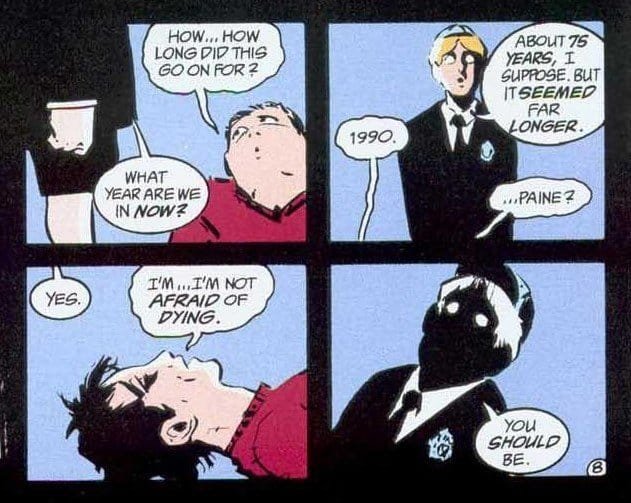
The Dead Boys Detectives appeared for the first time during the “Season of Mists” storyline, in Sandman #25. The characters’ story is a spin on the literary genre of teenage detectives, with macabre and ironic elements on it.
The main charecters are the ghosts of two dead boys, Charles Rowland and Edward Paine, who instead of entering the afterlife decide to stay on Earth to investigate crimes based on the supernatural.
After their introduction on the Seasons of Mist, Gaiman revived the characters for the “The Children’s Crusade” crossover that run through Vertigo’s annuals form December 1993 / January 1994, and in 2001 they got a four issues miniseries, called Sandman Presents: Dead Boy Detectives.
The miniseries was written by Ed Brubaker and pencilled by Brian Talbot, and in it the two boys searck for a killer that is stalking London’s homeless teenagers and kids, leaving their corpses floating in the Thames river.
This miniseries is not as good as the Sandman material, but if you read it and liked the characters it’s worth the try… you may get it quite cheap, anyway!
The Corinthian: Death in Venice

The Corinthian was a character first introduced in issue #8 of the regular series, during the “Doll’s House” storyline, as a nightmare created by Dream. His most remarkable features are that he is a relentless assassin, and that he has no eyes. In its place, he has two sets of teeth, that’s why he usually has to cover his eyes with sunglasses.
In this spin-off three issues miniseries, we explore the early years of The Corinthian, as he learns how to murder other human beings. The story is set in 1920, in Venice, Italy, and includes political elements and a certain Charles Constantine, who happens to be a relative of John Constantine (from Hellblazer).
The story is by Darko Macan and the art by Danijel Zezelj. If you liked the Corinthian as a character from the original series, is worth giving it a try. You can buy here the digital issues, remember you have to buy all three to read the story (they’re cheap, anyway…)
The Dreaming
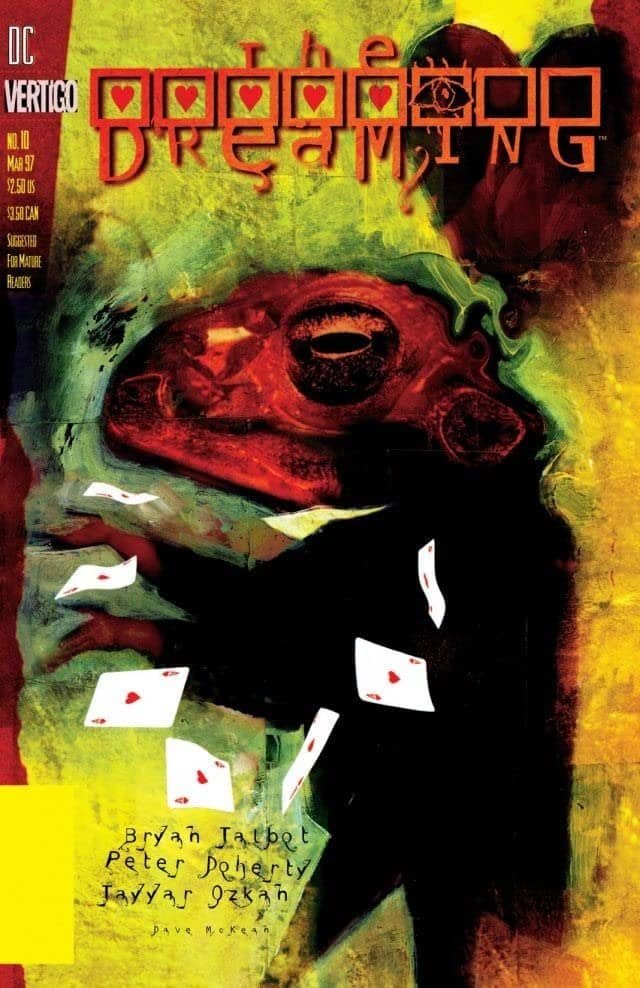
This series started in 1996 and run for 60 issues. While always being at the shadow of The Sandman original series, some story arcs were good. The stories occurred basically within Dream’s domains, and they featured many of the secondary characters from the main story. Characters on the book included The Corinthian, Matthew The Raven, Cain and Abel, Lucien, Nuala, Eve, and Mervyn Pumpkinhead, as well as some appearances from the Endless themselves.
The series started as an anthology of short stories by different writers and artists, with Neil Gaiman acting as creative consultant to the series. But after issue 21, the series mutated from anthology to an ongoing series that concentrated on a limited group of chore characters.
Even when the stories are not nearly as good as the ones in original Sandman series, it’s worth reading. The first three books are probably the best, are easy to find, and relatively cheap to give it a try.
And the covers by Dave McKean… delicious!!
The Thessaliad & Thessaly: Witch for Hire

During the regular Sandman series, in A Game Of You, we’re introduced to Thessaly, last of the witches of Thesally. She’s a cold-blooded, amoral character that won’t doubt to kill any potential threats without a hint of remorse or hesitation.
The character reappears now and then, and she turns Dream’s lover for some time, but the relationship doesn’t end well. We can see her in The Kindly Ones saga, and in The Wake.
Thessaly also stars in these two spin-offs, by Bill Willingham and Shawn McManus, where we can see her confront some underworld gods who want her dead, and in the second one, taking a monster killing contract. Both series, specially the second one, are fun to read, and you can easily find them on Amazon.
Well, you took a ride along the Dreaming realms. As you might see, you have every type of characters, and most stories are very entertaining and, specially the ones written by Gaiman, very enjoyable to read. Gaiman words wrap you up and transport you to mythical worlds, an effect not so many writers had in me (maybe only similar to what Borges, a local Argentinean writer, did).
So if you haven’t done it yet, go for the regular series. If you already have read it, these specials, series and miniseries may amplify your experience within the Sandman’s Universe. Lay down and enjoy!
And as we always say… keep reading good comics!

